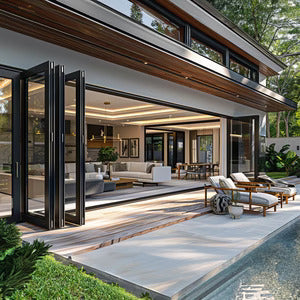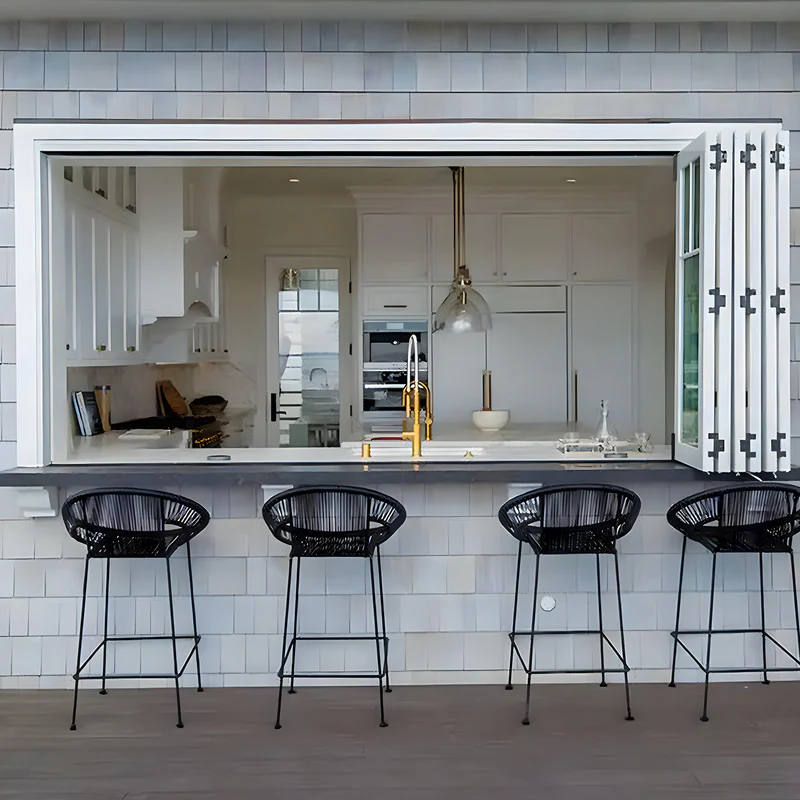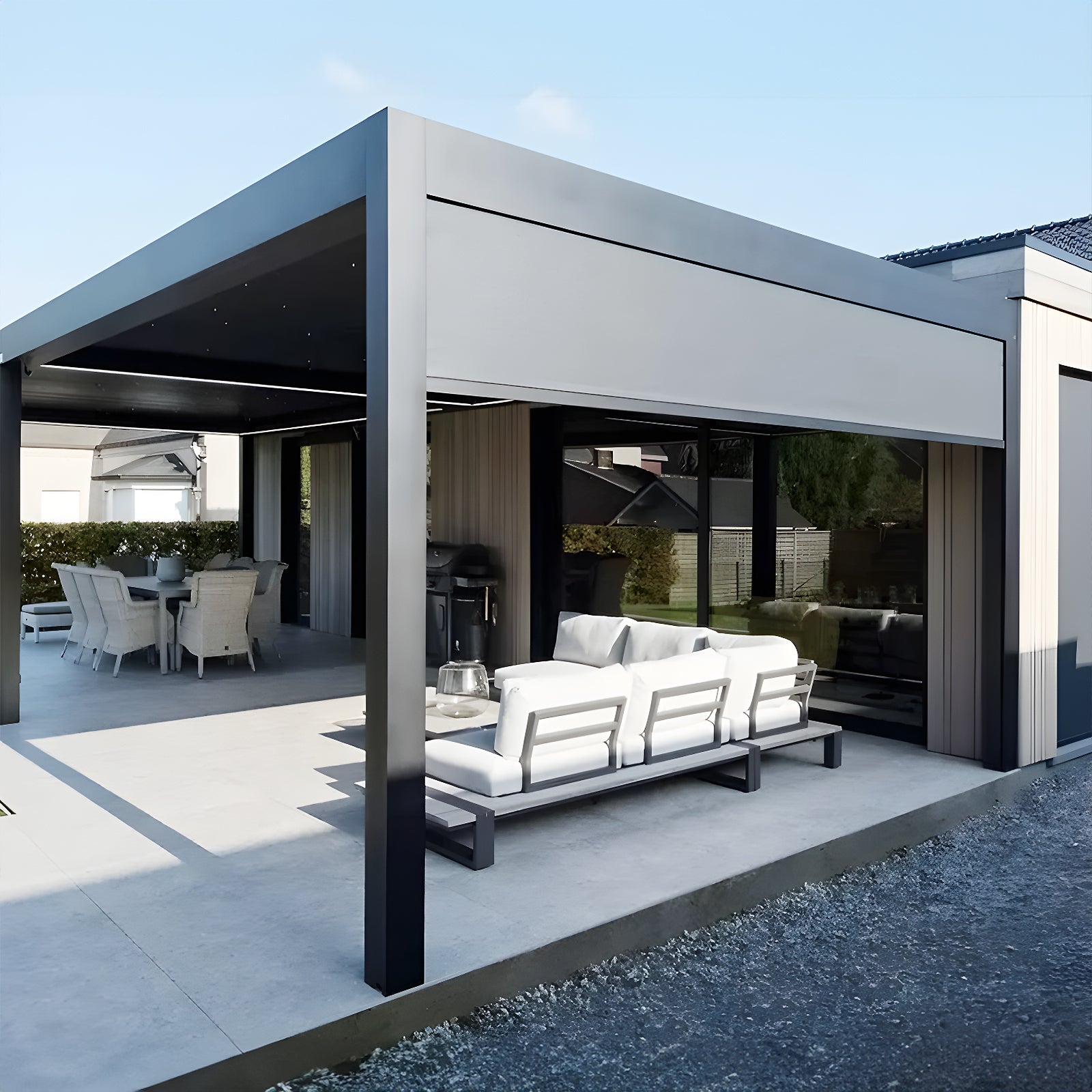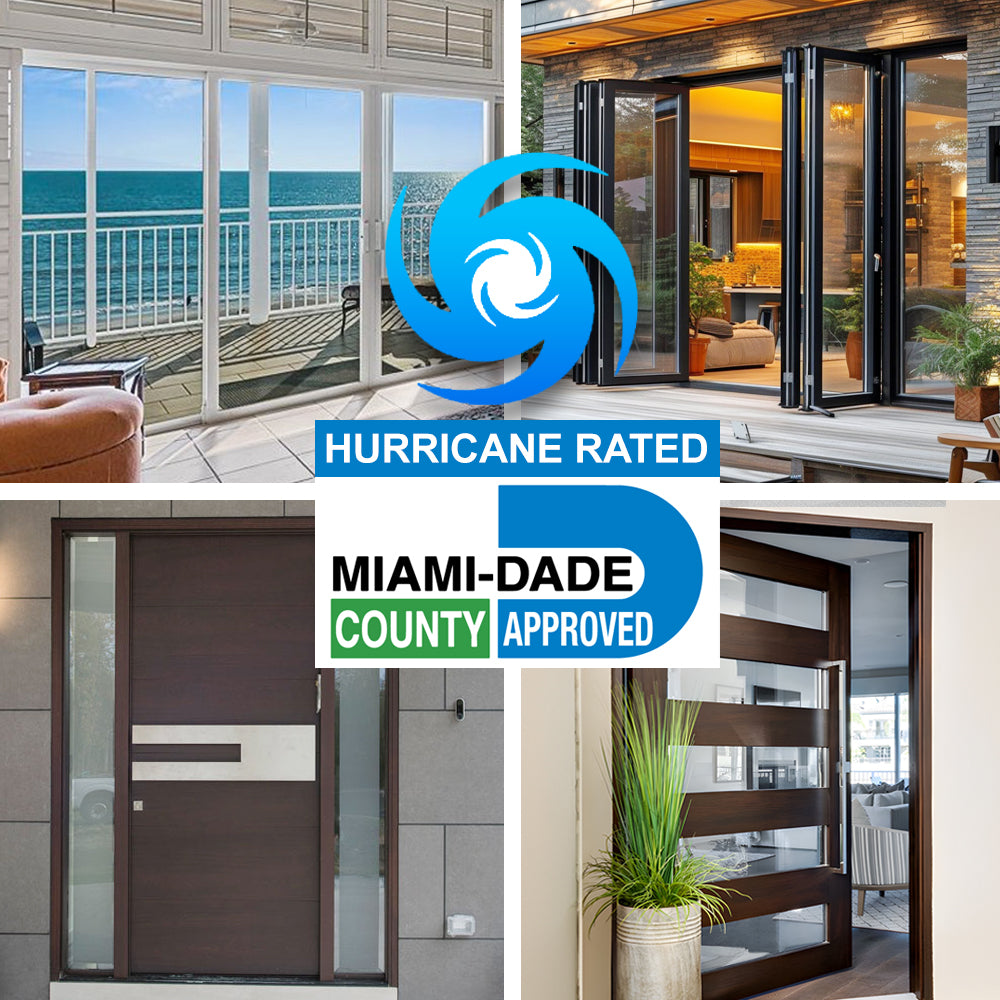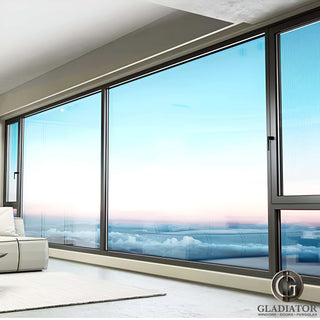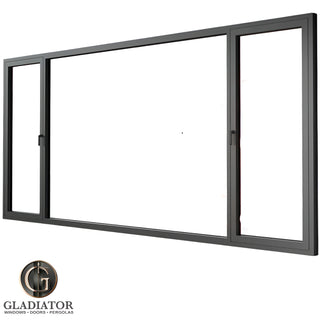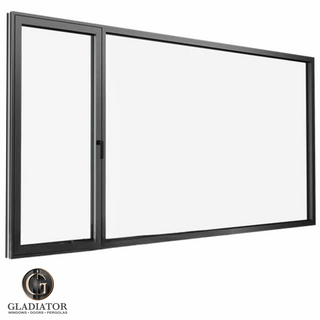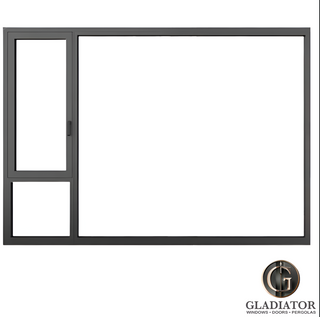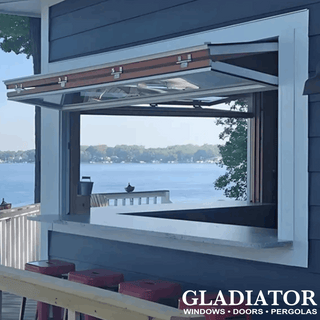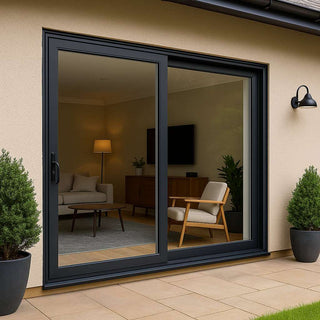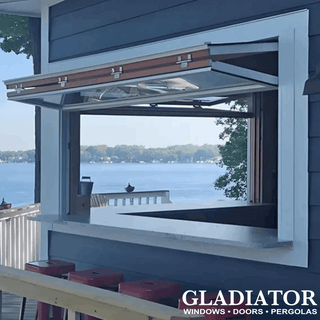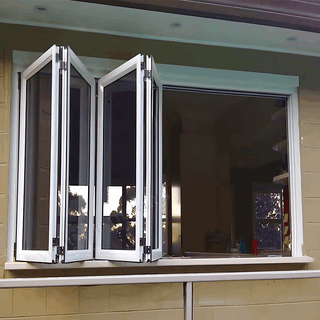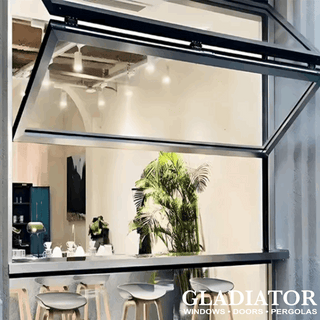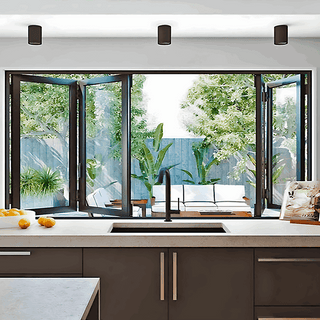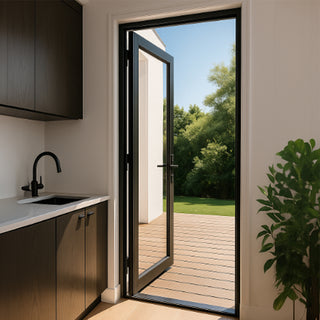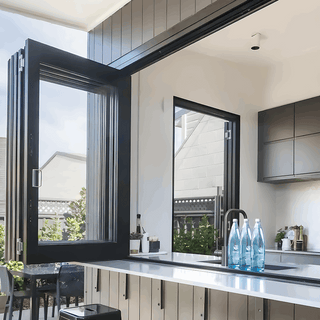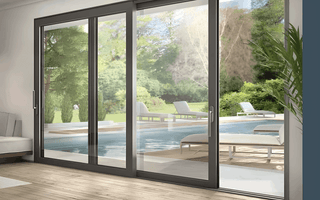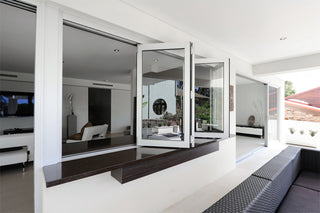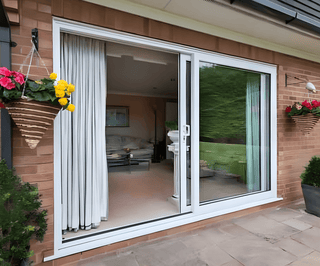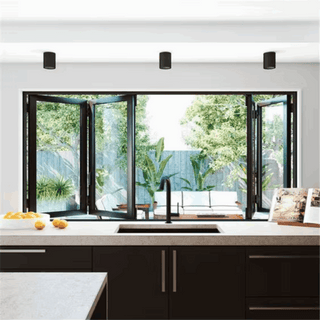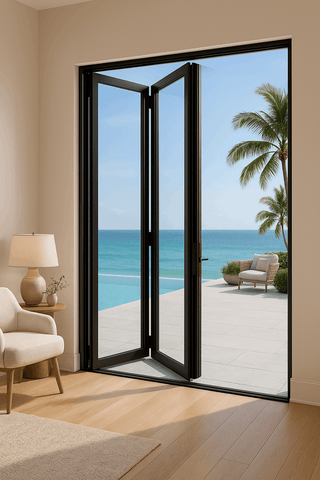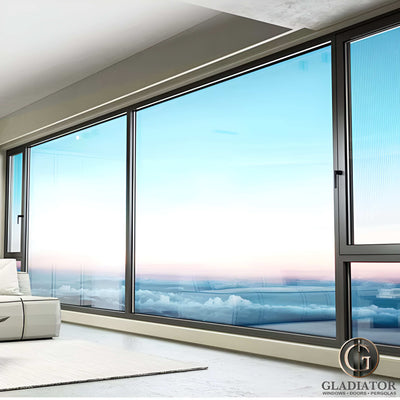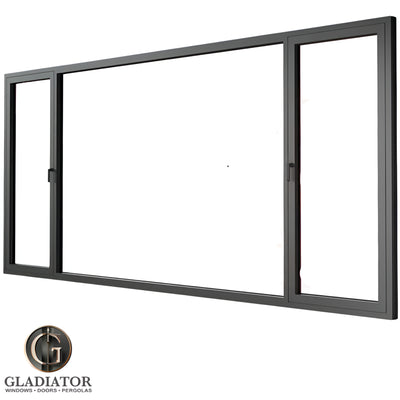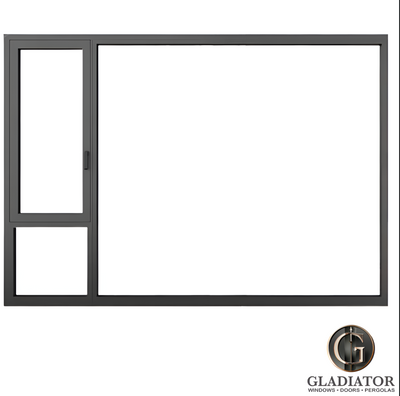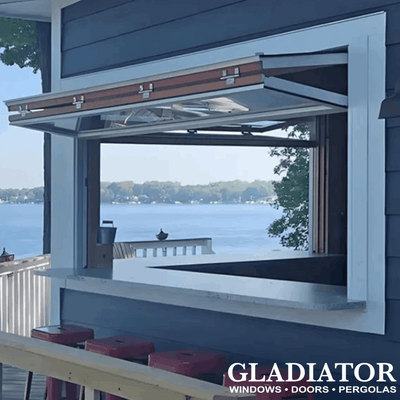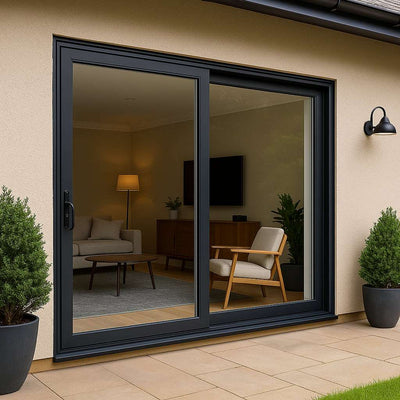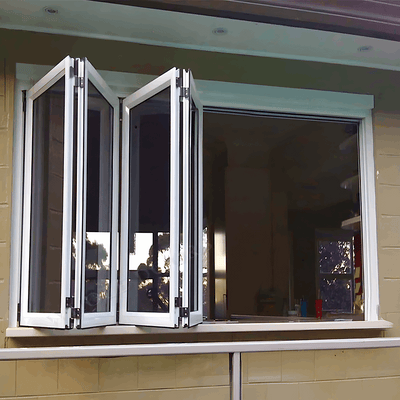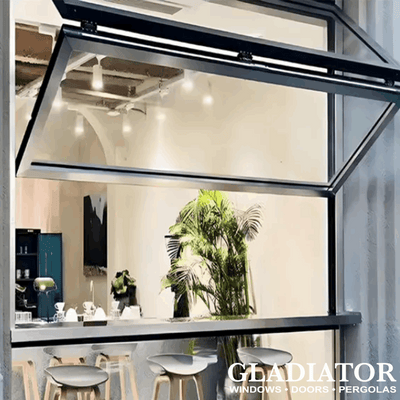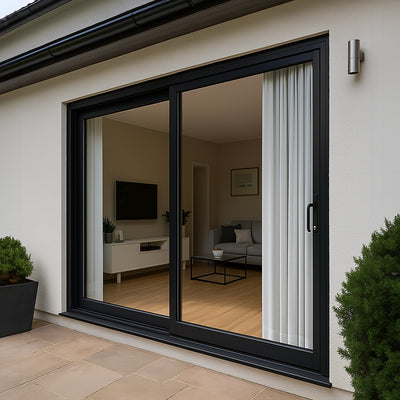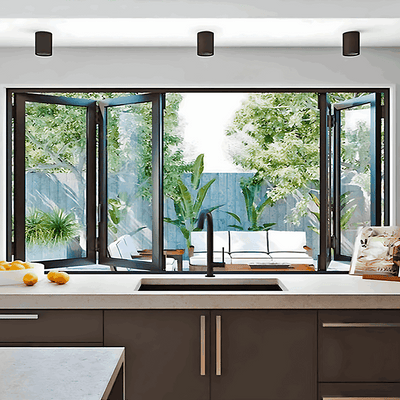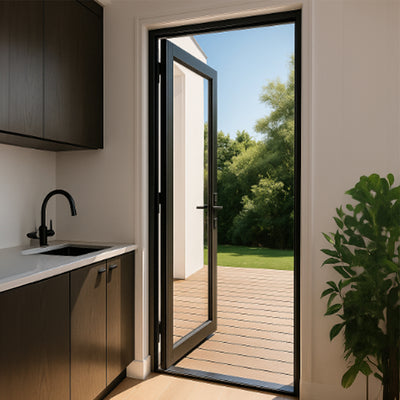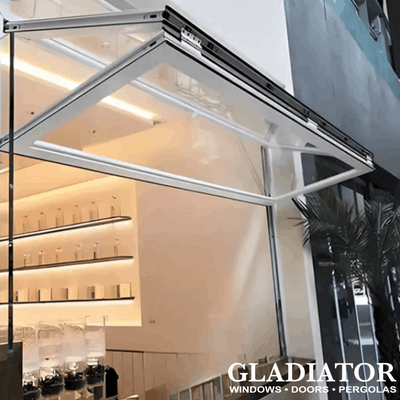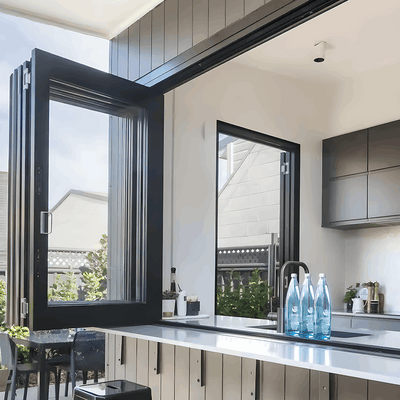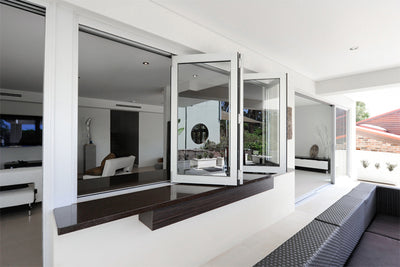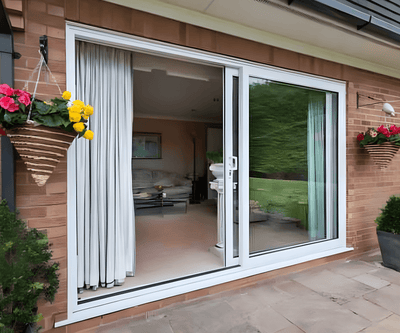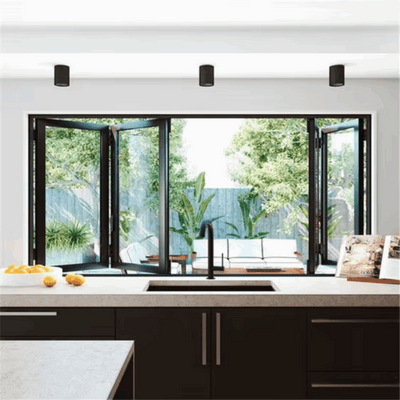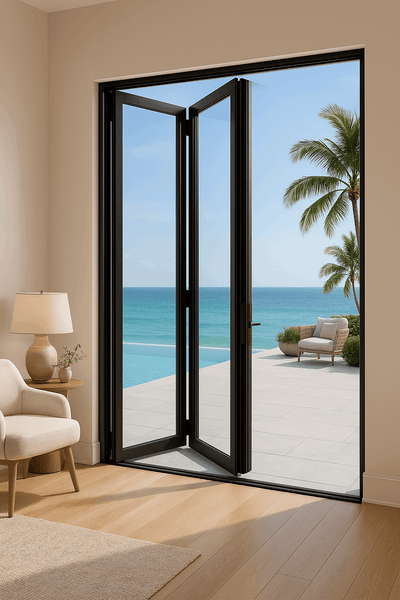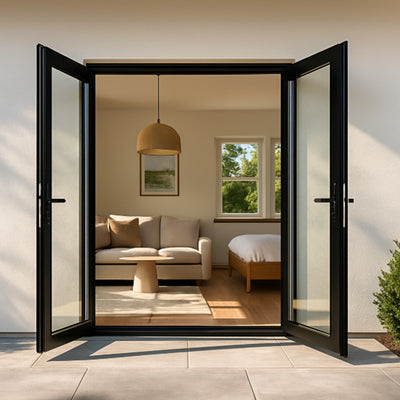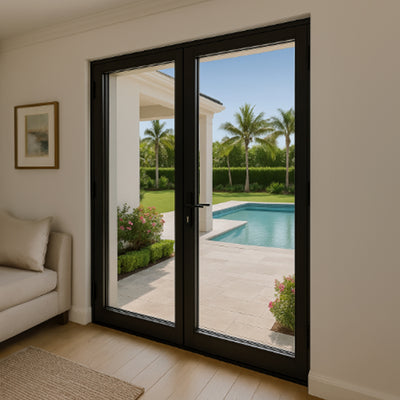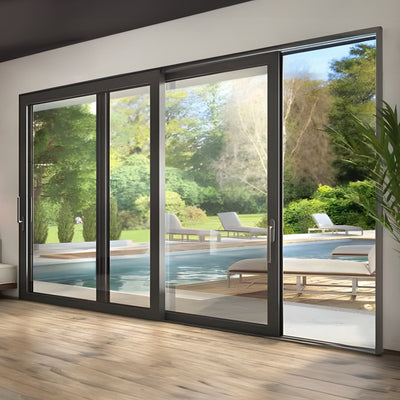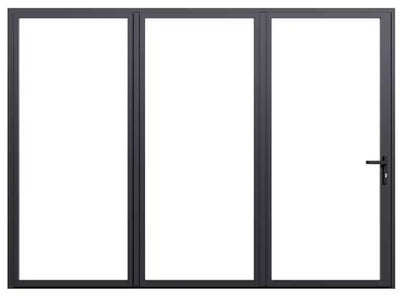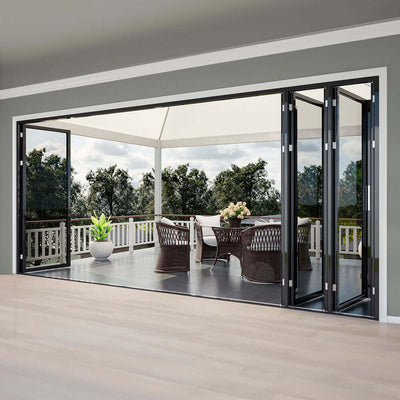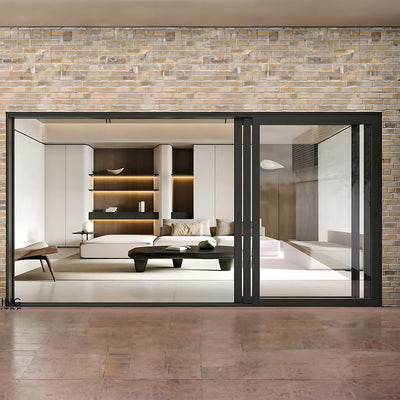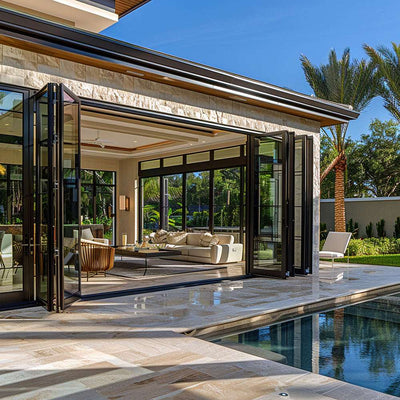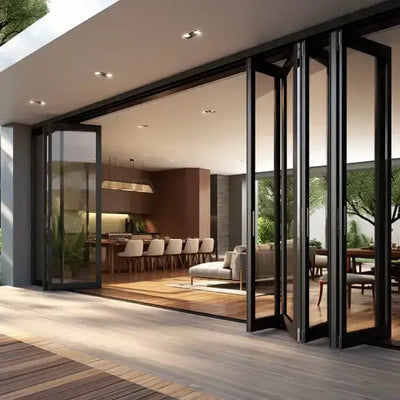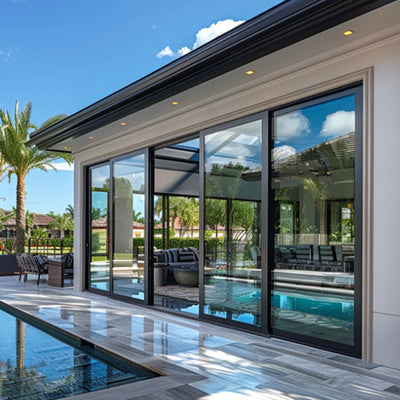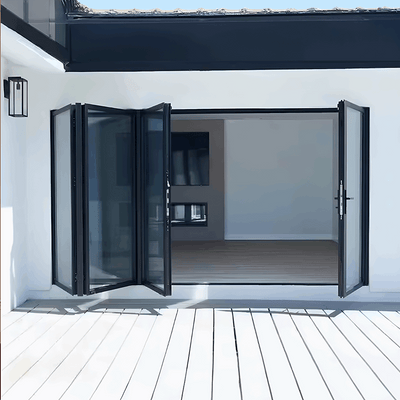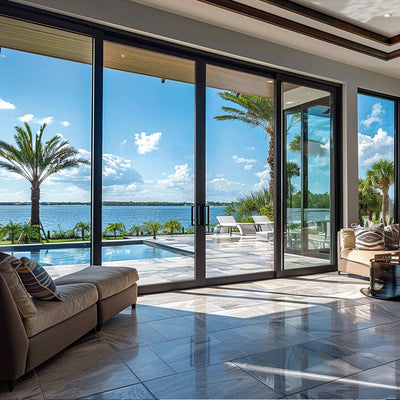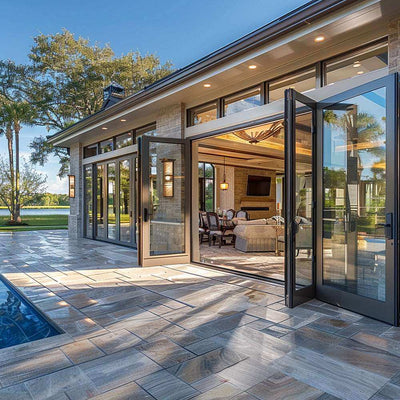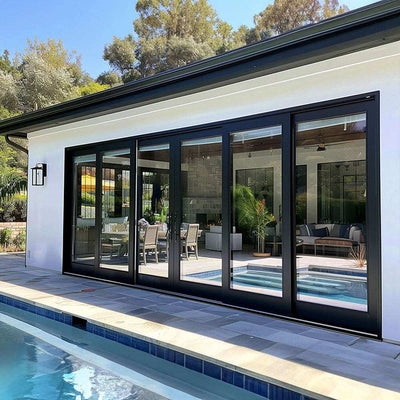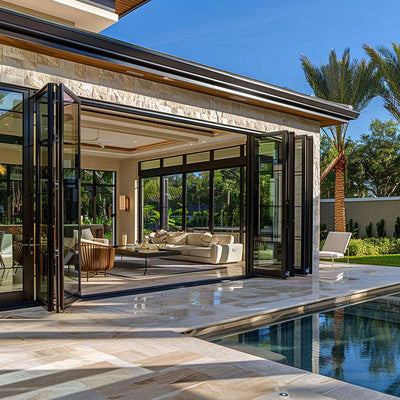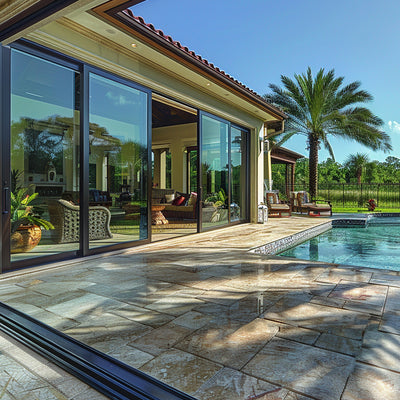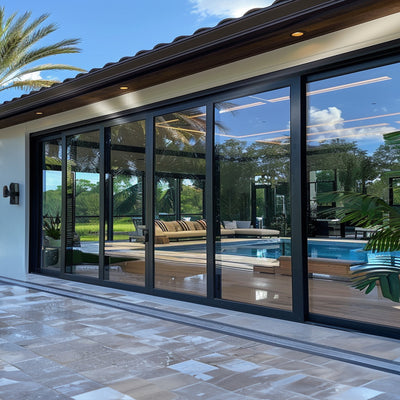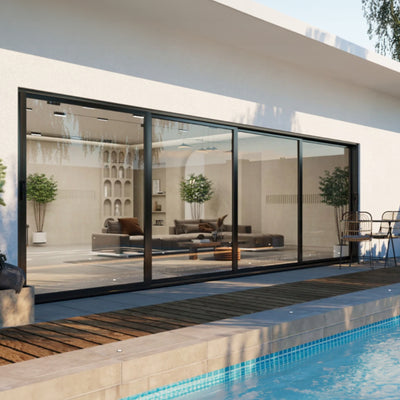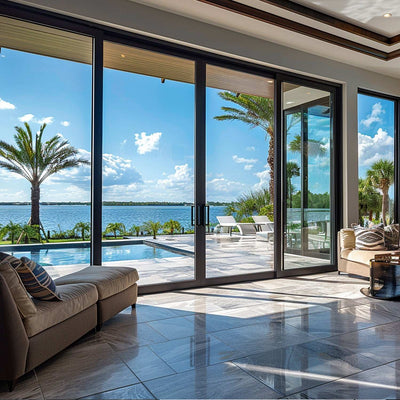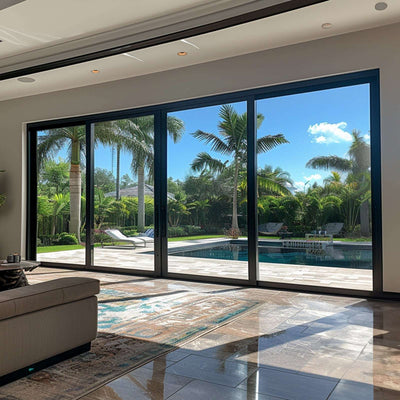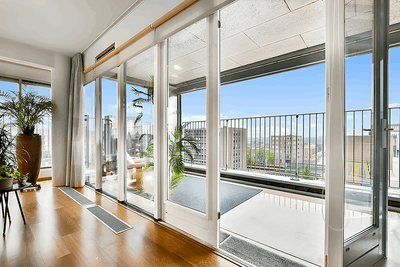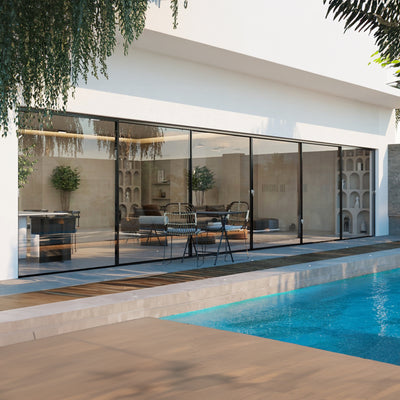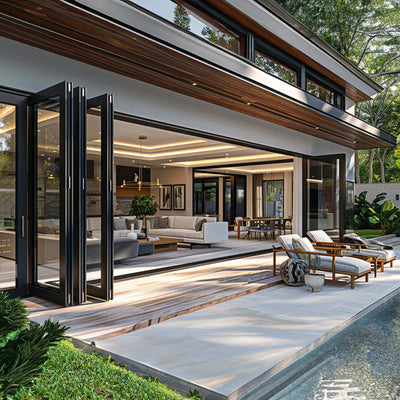Unfolding the Options: A Guide to Different Door Types
Choosing between folding doors vs sliding doors and other styles can dramatically affect your space. This guide clarifies the key differences between six popular options: bi-fold doors, pocket sliding doors, bypass sliding doors, multi-slide patio doors, sliding barn doors, and telescoping sliding doors. Understanding these options empowers you to make the best choice for your project, whether a renovation or new construction. Learn about each door type's benefits and drawbacks to maximize both functionality and style.
1. Bi-fold Doors
Bi-fold doors offer a unique and stylish approach to space management, making them a strong contender in the folding doors vs sliding doors debate. These doors operate on a system of multiple panels hinged together. These panels fold in pairs, resembling an accordion or concertina, as they slide along a top-hung track with bottom guides. This design allows them to stack neatly against the wall when fully open, maximizing the accessible space. This makes them an excellent choice for areas where maximizing opening space is crucial, such as closets, pantries, and room dividers. Bi-fold doors are available in a variety of materials, including wood, aluminum, glass, and vinyl, offering flexibility in design and application for both interior and exterior use. They can be configured with anywhere from two to eight panels, accommodating various opening widths.

Bi-fold doors are a popular choice due to their ability to maximize space. Their configuration options and diverse material choices make them suitable for various applications, from sleek modern interiors to connecting indoor and outdoor living spaces. For example, NanaWall Systems offers high-end folding glass door systems that create stunning transitions between interior and exterior spaces in luxury homes. More budget-friendly options, like IKEA's PAX wardrobe system, demonstrate the versatility of bi-fold doors for everyday storage solutions. Restaurants often utilize bi-fold doors to create flexible indoor-outdoor dining spaces, while modern offices employ glass bi-fold partitions for adaptable meeting rooms.
The following infographic helps visualize the decision-making process when considering bi-fold doors. It presents a decision tree to guide you through the key considerations.

The infographic highlights the key decisions involved in choosing bi-fold doors, starting with determining the desired opening size and then considering factors like budget, material preferences, and desired functionality. It guides users towards the best bi-fold door solution based on their specific needs and priorities.
Pros:
- Maximizes opening space: Bi-fold doors fold back neatly, providing almost complete access to the opening.
- Space-saving: They require less clearance space than traditional swing doors.
- Aesthetically pleasing: Bi-fold doors, particularly glass configurations, create a visually striking design element.
- Indoor-outdoor connection: Excellent for seamlessly blending indoor and outdoor living spaces.
- Ideal for limited side space: Perfect for areas where swinging doors aren't feasible.
Cons:
- Cost: Generally more expensive than standard sliding doors.
- Maintenance: Multiple hinges and tracks require regular lubrication and maintenance.
- Weather resistance: Not as weather-tight as some other door types, making them less suitable for harsh climates.
- Floor space: Occupies some floor space when folded open.
- Installation complexity: Requires precise installation by experienced professionals.
Tips for Choosing and Maintaining Bi-fold Doors:
- Structural support: Ensure the header above the door opening can support the weight of the bi-fold system.
- High-quality hardware: Invest in durable hardware for smoother operation and longevity.
- Thermal performance: Consider thermal efficiency if using bi-fold doors for exterior applications.
- Regular lubrication: Lubricate hinges and tracks regularly to maintain optimal performance.
- Weather-resistant materials: Choose weather-resistant materials like aluminum or vinyl for exterior installations.
Companies like Nana Wall Systems, LaCantina Doors, Andersen Windows & Doors, JELD-WEN, and Marvin have popularized the use of bi-fold doors in various architectural applications. Learn more about Bi-fold Doors to explore further details and options. When weighing folding doors vs sliding doors, bi-fold doors emerge as a compelling choice for homeowners, contractors, and builders seeking a stylish and space-efficient solution. They offer a unique blend of functionality and aesthetics, making them suitable for a wide range of projects, from residential renovations to commercial developments.
2. Pocket Sliding Doors
When comparing folding doors vs sliding doors, pocket sliding doors offer a unique space-saving solution. They slide completely into a hollow section of the wall (the 'pocket') when opened, effectively disappearing from view and maximizing floor space. When closed, they function like a normal door while offering a sleek, minimalist appearance. This makes them a compelling alternative to both traditional swing doors and other sliding door styles.
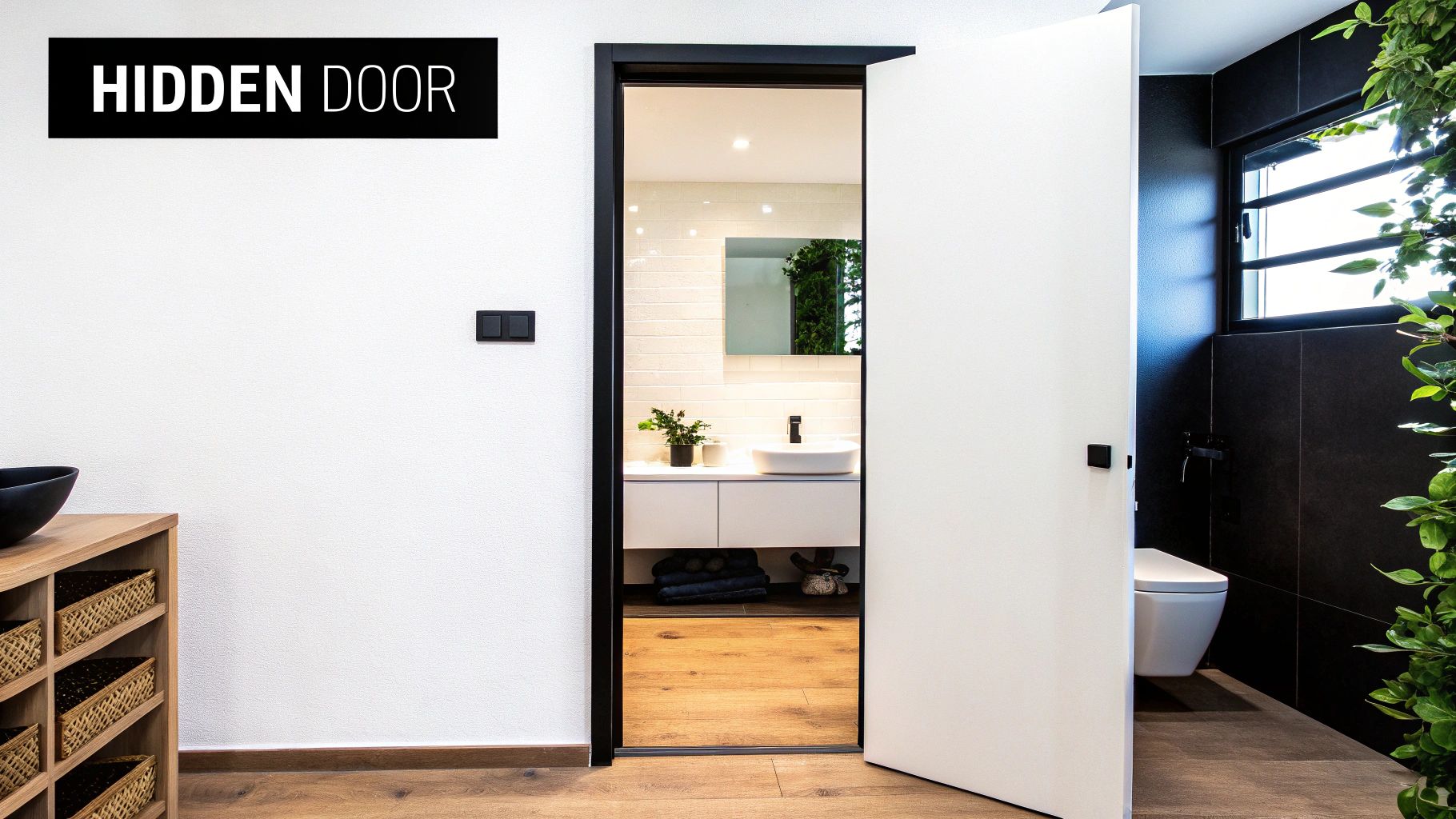
Pocket doors typically run on a single track with rollers and are available in various materials and styles, from wood to glass and modern to traditional. They can be single or double-sided, where two doors slide into opposite wall pockets, further enhancing their space-saving capabilities. They usually feature flush pulls or recessed handles for a streamlined look. This door type is ideal for maximizing space in small areas where a traditional swing door would be impractical. Examples include small apartment bathrooms, butler's pantries in high-end kitchens, or home offices that convert to guest rooms. Their clean lines and uninterrupted wall space make them popular in modern minimalist homes. They are also advantageous in ADA-compliant spaces requiring wide doorways. Learn more about Pocket Sliding Doors
Features and Benefits:
- Complete Space Saving: Pocket doors save 100% of the swing space required by traditional doors. This is a major advantage in tight spaces where every square foot counts.
- Seamless Transitions: They create a seamless transition between rooms when open, contributing to a more open and flowing floor plan.
- Aesthetically Pleasing: Pocket doors provide clean lines and uninterrupted wall space, enhancing the visual appeal of a room. They are often a key feature in contemporary designs.
- Full Access: Unlike some sliding doors that only open partially, pocket doors allow for full access to the doorway opening.
Pros:
- Saves 100% of the swing space required by a traditional door
- Creates clean lines and uninterrupted wall space when open
- Ideal for small spaces like bathrooms, pantries, and laundry rooms
- Provides full access to the doorway opening
- Creates a seamless transition between rooms
Cons:
- Installation requires specialized wall framing (difficult in retrofits)
- Repairs can be complicated once the wall is finished
- Limited soundproofing compared to solid doors
- Not suitable for exterior applications without significant modifications
- Hardware failures can be difficult to fix
Tips for Successful Implementation:
- Solid Blocking: Install solid blocking within the pocket wall frame for secure mounting of handles, locks, and the track system itself.
- High-Quality Hardware: Invest in high-quality hardware systems specifically designed for pocket doors. This ensures smooth operation and longevity.
- Soundproofing: Consider soundproofing the pocket cavity with insulation for improved acoustics.
- Pre-Drywall Installation: Install the pocket door system before finishing the drywall for easier adjustments and troubleshooting.
- Lightweight Materials: Choose lightweight door materials to reduce strain on the hardware and ensure smooth operation.
Pocket doors are a valuable option in the folding doors vs sliding doors debate, offering a unique blend of functionality and aesthetics that makes them a desirable choice for a wide range of applications. They are particularly well-suited to modern design sensibilities and space-conscious homeowners, builders, and contractors.
3. Bypass Sliding Doors
When comparing folding doors vs sliding doors, bypass sliding doors offer a distinct solution with its own set of advantages and disadvantages. This system employs two or more panels that slide horizontally on parallel tracks, overlapping or 'bypassing' each other as they open and close. Unlike folding doors which fold and stack, bypass doors maintain a straight configuration, making them a popular choice for areas where space is at a premium.
Bypass sliding doors work by hanging the individual panels from a top track with bottom guides ensuring smooth and stable movement. The overlapping design allows for partial access to the opening, with one panel's width always covering a portion of the space. This mechanism is simpler than bifold doors, involving fewer moving parts.
Why Choose Bypass Sliding Doors?
Bypass doors earn their place in the "folding doors vs sliding doors" debate due to their space-saving design and ease of operation. They are particularly well-suited for situations where swinging doors are impractical, such as narrow hallways or tight closets. Their simple construction also makes them a generally cost-effective choice.
Features and Benefits:
- Space-saving: Eliminate the need for swing space, making them ideal for compact areas.
- Simple operation: Fewer moving parts than bi-fold doors contribute to easier handling.
- Cost-effective: Generally less expensive than pocket or more complex folding door systems.
- Variety of materials: Available in mirrored, glass, wood, and composite materials, offering design flexibility.
- Easy installation: Relatively straightforward to install compared to pocket doors.
Pros and Cons:
Pros:
- No swing space required.
- Simple operation.
- Cost-effective.
- Easy installation.
Cons:
- Limited access to the full opening width.
- Can feel heavy to operate, especially with large panels.
- Tracks can collect dust and debris.
- Less aesthetically striking than some other door styles.
- Potential for derailment if not properly maintained.
Examples of Successful Implementation:
- Closet doors: A standard application in many homes and apartments.
- Patio doors: Sliding glass patio doors provide a seamless transition between indoor and outdoor spaces.
- Bathroom doors: Frequently used in hotels and compact bathrooms where space is limited.
- Office dividers: Can be used to create flexible partitions in office spaces or meeting rooms.
Actionable Tips:
- Invest in quality: Install high-quality rollers for smooth and quiet operation.
- Regular maintenance: Clean the tracks regularly to prevent dust buildup and ensure smooth gliding.
- Soft-close mechanisms: Consider adding soft-close mechanisms to prevent slamming and increase the lifespan of the doors.
- Door stops: Install door stops to prevent damage from over-sliding.
- Periodic adjustments: Adjust the rollers periodically to maintain proper alignment and prevent derailment.
Popular Manufacturers:
Several reputable manufacturers offer bypass sliding door systems, including Stanley Door Systems, Reliable Corporation, Andersen Windows & Doors, JELD-WEN, and Pella.
By carefully weighing the pros and cons and considering the specific needs of your space, you can determine whether bypass sliding doors are the right choice in your "folding doors vs sliding doors" decision-making process. They represent a practical and often economical solution for maximizing space and functionality in various applications.
4. Multi-Slide Patio Doors
Multi-slide patio doors represent a significant step up from traditional sliding glass doors, offering a grander scale and a more seamless transition between indoor and outdoor spaces. These systems utilize multiple large glass panels, typically ranging from three to ten, which glide along parallel tracks. Unlike standard sliding doors, multi-slide doors can stack neatly at the side or disappear entirely into wall pockets, creating expansive openings that can span up to 50 feet or more. This makes them a compelling option in the "folding doors vs sliding doors" debate when maximizing the opening and view is paramount.
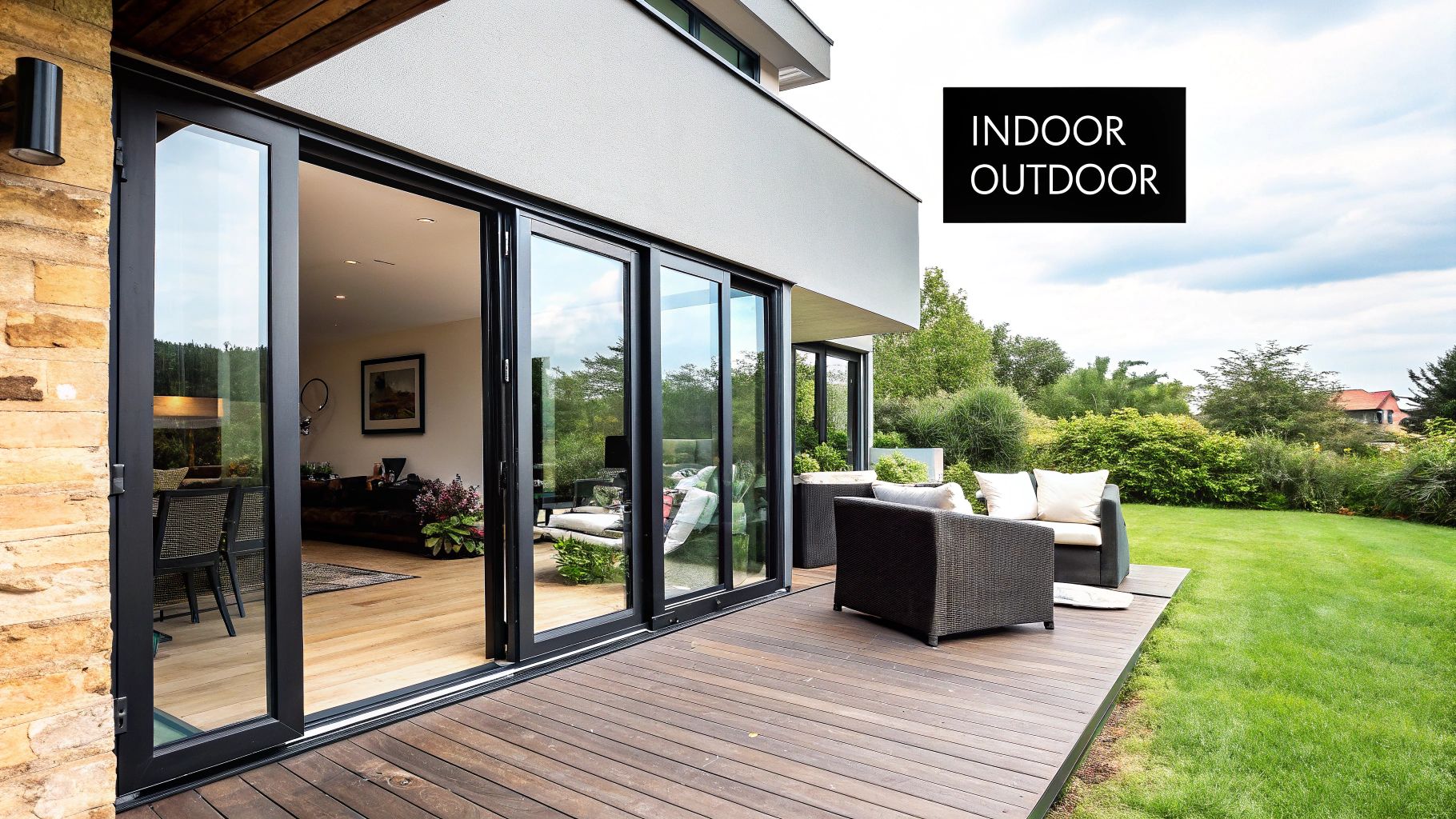
Multi-slide doors are engineered with heavy-duty rollers and tracks to ensure smooth operation despite the substantial weight of the glass panels. They are also designed with weatherproofing and thermal break technology to enhance energy efficiency and protect against the elements. Configurations allow for panels to slide in a single direction or from both sides to meet in the middle, providing flexibility in how the space is used. This versatility earns them a place in the "folding doors vs sliding doors" discussion, offering an alternative that excels in creating expansive openings.
Imagine a luxury oceanfront home where the living room wall seemingly disappears, revealing breathtaking beach views. Or picture a high-end restaurant with a multi-slide system that seamlessly merges the indoor dining area with a patio space. These are just a few examples of how multi-slide doors are being used to create dramatic and functional spaces. Modern architectural homes, resort hotels, and contemporary office spaces also benefit from the panoramic views and flexible indoor-outdoor environments that multi-slide doors provide. Learn more about Multi-Slide Patio Doors for more specific examples and applications.
Pros:
- Creates dramatic, wide openings up to 50 feet or more.
- Maximizes natural light and offers unobstructed views.
- Blurs the lines between indoor and outdoor living.
- Can completely disappear into wall pockets for a seamless transition.
- Modern, luxurious aesthetic appeal.
Cons:
- Significantly more expensive than standard sliding or folding doors.
- Requires robust structural support, adding to project costs.
- Complex installation demands experienced professionals.
- Weatherproofing can be more challenging compared to simpler door systems.
- Higher maintenance requirements due to the complexity of the system.
Tips for Homeowners, Contractors, and Builders:
- Structural Support: Ensure adequate structural support in the header to handle the weight of the door system. This is crucial for safe and proper operation.
- Motorization: Consider motorized operation for very large systems to ease opening and closing, especially for accessibility.
- Weatherproofing: Invest in high-quality weatherstripping and seals to prevent drafts and water infiltration.
- Energy Efficiency: Choose low-E glass to maximize energy efficiency and minimize heat transfer.
- Drainage: Plan for proper drainage in the track system to prevent water accumulation and damage.
Companies like Western Window Systems, Panda Windows & Doors, LaCantina Doors, Fleetwood Windows & Doors, and Weiland by Andersen have been instrumental in popularizing this style of door, showcasing its potential in a range of architectural applications. If you're considering multi-slide doors for your project, carefully weigh the pros and cons and ensure you're prepared for the investment and installation requirements. When choosing between "folding doors vs sliding doors", multi-slide systems offer a unique solution for maximizing space and creating a truly impressive connection with the outdoors.
5. Sliding Barn Doors
When comparing folding doors vs sliding doors, sliding barn doors offer a unique blend of style and functionality. These single-panel doors hang from an exposed track mounted above the doorway, sliding parallel to the wall rather than swinging inwards or outwards. Inspired by their namesake, they've evolved from rustic origins to become a trendy design element in both residential and commercial spaces. They effectively serve as both a practical door solution and a striking visual feature.
Sliding barn doors operate on a simple principle: a large, typically decorative, hardware system with rollers allows the door panel to glide smoothly along the overhead track. This track is mounted directly to the wall surface, making barn doors a relatively easy retrofit solution compared to pocket doors which require in-wall framing. Because the door slides parallel to the wall, they eliminate the need for swing space required by traditional hinged doors, making them an excellent option for tight spaces.
Features and Benefits:
- Single-panel design: Provides a clean, modern look.
- Exposed hardware: Adds to the aesthetic appeal and offers customization options.
- Variety of materials: Available in a range of materials from rustic wood (like reclaimed timber) to modern glass and even metal, catering to various design styles.
- Customizable size: Can be made to fit a wide range of openings, including extra-wide doorways where traditional doors might be impractical.
- Easy installation (especially for retrofits): Simpler installation process compared to pocket doors.
Pros:
- Bold design statement: Instantly elevates a space with visual interest.
- Space-saving: Requires no swing clearance, ideal for smaller rooms or hallways.
- Easy retrofit: Can be installed without major demolition.
- Covers wide openings: Suitable for larger doorways and openings.
- Versatile style: From farmhouse to industrial to contemporary, there's a barn door style for every aesthetic.
Cons:
- Limited sound and privacy control: Doesn't provide a tight seal, resulting in less sound insulation and privacy compared to traditional doors.
- Requires wall space: Needs sufficient adjacent wall space to accommodate the sliding door panel.
- Partial wall overlap: The door partially obstructs the wall when open.
- Potential noise: Can be noisy during operation if not fitted with soft-close mechanisms.
- May require floor guides: Floor guides are sometimes necessary to prevent the door from swinging and maintain alignment.
Examples of Successful Implementation:
- Farmhouse-style bathrooms: Creates a rustic yet elegant entry to the master bathroom.
- Restaurant restrooms: Offers a unique and stylish alternative to traditional doors. Custom branded designs can add a personalized touch.
- Modern office meeting rooms: Glass barn doors provide a sense of openness while still offering some division and privacy.
- Pantry entrances in open-concept kitchens: Adds a stylish and functional element to conceal pantry contents.
- Room dividers in loft apartments: Provides a flexible and stylish way to divide large open spaces.
Actionable Tips for Installation and Use:
- Structural Support: Ensure the wall mounting area has adequate blocking or reinforced framing to support the weight of the door and hardware.
- Clearance: Allow at least 1 inch of height clearance above the door frame for the hardware installation.
- Soft-Close Mechanisms: Install soft-close mechanisms to prevent slamming and reduce noise.
- Floor Guides: Use floor guides to keep the door aligned and prevent it from swinging.
- Handle Selection: Choose an appropriate handle style to avoid finger pinching between the door and the wall.
When and Why to Choose Sliding Barn Doors:
Sliding barn doors are an excellent choice when you're looking to make a design statement while optimizing space. They are particularly well-suited for areas where swing clearance is limited, such as small bathrooms, hallways, or closets. Their versatility in style makes them adaptable to a wide range of interior design aesthetics. If you prioritize style and space-saving functionality over complete privacy and soundproofing, sliding barn doors are a great option.
Learn more about Sliding Barn Doors
This style of door was popularized by figures like Joanna Gaines from the TV show Fixer Upper, as well as companies like Rustica Hardware and Artisan Hardware. The popularity of sliding barn doors has also been significantly driven by social media platforms like Pinterest and Instagram, showcasing their versatile applications in various interior design styles. This widespread popularity, combined with their unique blend of form and function, earns the sliding barn door a deserving place on this list comparing folding doors vs sliding doors.
6. Telescoping Sliding Doors
When comparing folding doors vs sliding doors, telescoping sliding doors offer a unique solution that prioritizes maximizing opening width while minimizing stacking space. This makes them a strong contender in the "folding doors vs sliding doors" debate, particularly for those seeking expansive, unobstructed views and seamless transitions between indoor and outdoor spaces. Instead of folding like a bi-fold door or sliding on a single track, telescoping doors utilize multiple panels that slide and nest behind one another, much like a telescope collapsing.
These doors operate on a multi-track system, typically consisting of 3-5 tracks, allowing each panel to slide independently yet synchronously when operated. This ingenious design can create openings of 20 feet or more, significantly wider than standard sliding doors, while requiring considerably less stacking space compared to bi-fold doors. The panels often emphasize glass to maximize views and can even be configured for corner installations, truly blurring the lines between inside and out.
Imagine opening up an entire wall of your living room to a breathtaking ocean view or seamlessly connecting your indoor dining area with a poolside patio. This is the kind of transformative experience telescoping sliding doors provide. Luxury condo balconies maximizing cityscapes, high-end residential pool cabanas, upscale restaurant patios creating "disappearing walls," and modern office spaces with flexible conference room configurations are all prime examples of successful telescoping door implementation. Even retail storefronts are leveraging this technology to create inviting indoor-outdoor shopping experiences.
Features and Benefits:
- Maximized Openings: Creates significantly wider openings than standard sliding doors.
- Minimal Stacking Space: Requires less stacking space than bi-fold doors, preserving valuable floor space.
- Sleek Aesthetics: Offers a sleek, minimalist appearance with thin sight lines, enhancing the modern aesthetic.
- Panoramic Views: Excellent for maximizing panoramic views and creating a seamless connection with the outdoors.
- Smooth Operation: Features smooth, synchronous operation for effortless opening and closing.
Pros:
- Wider openings than standard sliding doors
- Less stacking space than bi-fold doors
- Sleek, minimalist appearance
- Smooth, synchronous operation
- Excellent for panoramic views and indoor-outdoor living
Cons:
- Complex installation requiring precise alignment
- Higher cost than standard sliding systems
- Multiple tracks can be challenging to keep clean
- Requires more maintenance than simpler door systems
- Heavy to operate manually in large configurations
Tips for Homeowners, Contractors, and Builders:
- Motorization: Consider motorized operation for larger systems, especially for ease of use and accessibility.
- Drainage: Install proper drainage systems in exterior applications to prevent water damage.
- Hardware: Use high-quality stainless steel hardware for coastal locations to resist corrosion.
- Maintenance: Clean and lubricate tracks regularly for smooth and long-lasting operation.
- Weather Sealing: Choose appropriate weather sealing based on your local climate conditions to ensure energy efficiency and protection from the elements.
Companies like Fleetwood Windows & Doors, Western Window Systems, Solar Innovations, Vitrocsa, and Arcadia Custom have popularized these systems and offer a range of options to suit various needs and budgets. Learn more about Telescoping Sliding Doors.
When choosing between folding doors vs sliding doors, if your priority is maximizing the opening while minimizing the stacked footprint, and you’re willing to invest in a higher-end system, then telescoping sliding doors deserve serious consideration. They provide a truly impressive way to connect indoor and outdoor spaces, bringing a touch of luxury and functionality to any project.
6-Door Types Feature Comparison
| Door Type | Implementation Complexity 🔄 | Resource Requirements 💡 | Expected Outcomes 📊 | Ideal Use Cases 💡 | Key Advantages ⭐ |
|---|---|---|---|---|---|
| Bi-fold Doors | High - Requires precise installation and structural support | Moderate to High - Multiple panels, hinges, tracks | Wide opening access, space maximization | Indoor/outdoor transitions, closets, pantries | Maximizes space, striking visuals, wide access |
| Pocket Sliding Doors | Moderate to High - Specialized wall framing needed | Moderate - Hardware and wall modification required | 100% swing space saved, seamless door disappearance | Small rooms, bathrooms, pantries, minimalist designs | Saves max space, clean look, full doorway access |
| Bypass Sliding Doors | Low to Moderate - Easier install, fewer parts | Low to Moderate - Simple track and panel system | Partial access to opening, no swing space needed | Closets, wardrobes, compact interior spaces | Cost-effective, simple operation, no swing space |
| Multi-Slide Patio Doors | Very High - Complex install, structural support | High - Multiple large panels, weatherproofing tech | Dramatic wide openings, panoramic views | Luxury homes, restaurants, modern indoor-outdoor | Large openings, luxury aesthetic, natural light |
| Sliding Barn Doors | Low - Surface mount, retrofit friendly | Low - Single panel, exposed hardware | No swing space, strong design statement | Farmhouse style rooms, room dividers, rustic interiors | Easy install, bold style, versatile look |
| Telescoping Sliding Doors | High - Precise multi-track system install | High - Multiple synchronized panels, hardware | Very wide openings with minimal stacking space | High-end indoor-outdoor spaces, panoramic views | Wide openings, smooth operation, sleek aesthetics |
Making the Right Choice: Finding Your Perfect Door
Choosing between folding doors vs sliding doors ultimately depends on your specific needs and priorities. We've explored a variety of options, from the compact efficiency of bi-fold and pocket doors to the expansive elegance of multi-slide patio doors and the rustic charm of sliding barn doors. Bypass and telescoping doors offer their own unique benefits, showcasing the versatility and adaptability of these door styles. Key takeaways include considering the space available, your budget, how the doors will function in your daily life, and the overall aesthetic you want to achieve.
When choosing between folding and sliding doors, consider how they can create multifunctional spaces. For example, a folding door can open up a living room to a patio, creating an indoor-outdoor space for entertaining. Sliding barn doors can be used to divide a large room into two smaller spaces, such as a home office and a guest room.
Mastering these considerations empowers you to transform your home, enhancing both its functionality and beauty. The right door can seamlessly connect spaces, maximize natural light, and improve traffic flow, ultimately elevating your living experience.
Whether you're envisioning a modern open-plan design or a cozy, compartmentalized layout, the perfect door is out there waiting to be discovered. Find the ideal folding or sliding door solution for your project with Gladiator Window and Doors. We offer a wide range of high-quality, custom-made options at unbeatable prices, ensuring you find the perfect fit for your needs and budget. Visit Gladiator Window and Doors today to explore our selection and take advantage of our Best Offer Guarantee.








